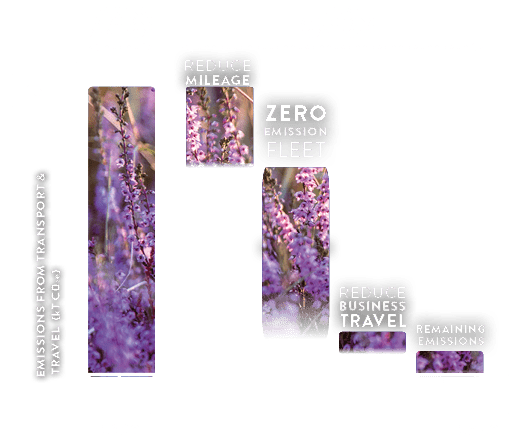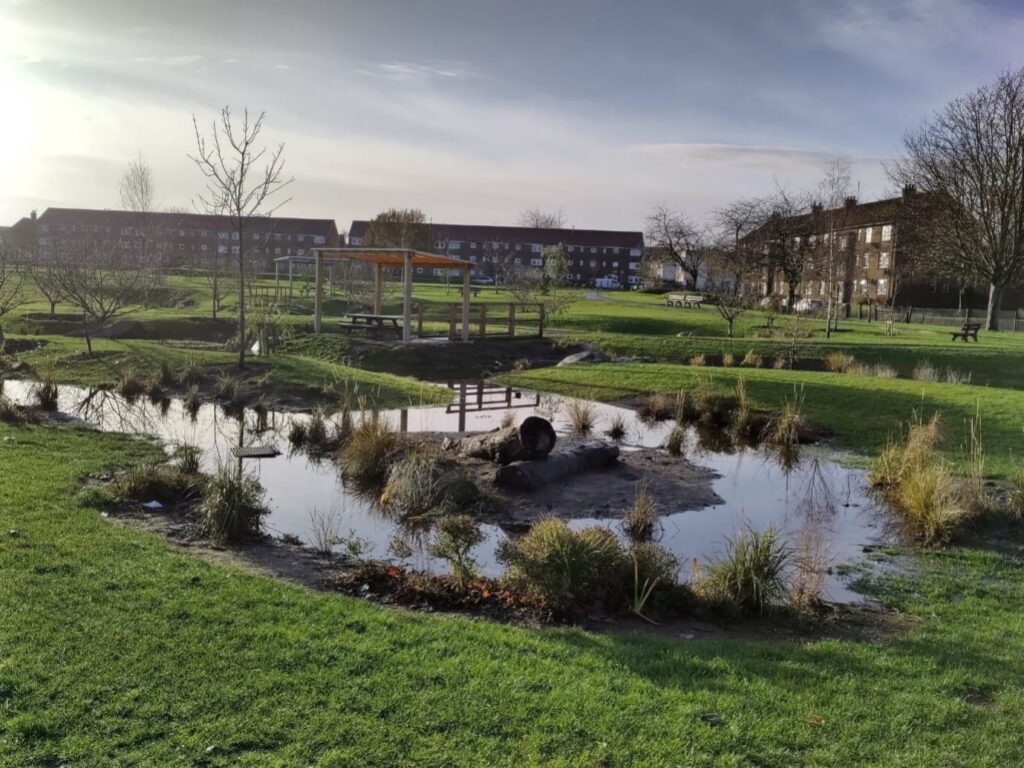Scottish Water’s fleet travels 19 million miles per annum.
Business travel – car, train and plane – make up the remainder of these emissions.
We currently have 21 electric vehicles.
Transport and travel led to 16ktCO2e of emissions.

2019/20 POSITION
19 million
MILES TRAVELLED
BY FLEET YEARLY
21
ELECTRIC VEHICLES
16ktCO2e
TOP 5 CONTRIBUTORS
TO TRANSPORT EMISSIONS
SLUDGE
TANKERING
WATER
OPERATIONS
WASTEWATER
OPERATIONS
BUSINESS
TRAVEL
OUR APPROACH

REDUCE MILES
TRAVELLED
REDUCE
BUSINESS TRAVEL
REPLACE FLEET WITH ZERO EMISSION VEHICLES
These tables illustrate the key activities we are
exploring to reduce our transport and travel emissions.
These tables illustrate the key activities we are exploring to reduce our transport
and travel emissions.

UP TO
2025
• Review learning from COVID-19 agile working to embed new practices and digital working to reduce fleet and business travel.
UP TO
2030
UP TO
2040
• Identify, assess and implement streamlined end to end processes that reduce fleet mileage. (e.g. increased remote monitoring
of sites to reduce visits).
• Continue to transform our end to end processes to reduce fleet mileage.
• Continue to transform our end to end processes to reduce fleet mileage.
• Maximise benefits of digital working to reduce business travel.
• Continue to maximise benefits of digital working to reduce business travel.
• All remaining business travel to be zero emissions.

UP TO
2025
• Review learning from COVID-19 agile working to embed new practices and digital working to reduce fleet and business travel.
• Identify, assess and implement streamlined end to end processes that reduce fleet mileage. (e.g. increased remote monitoring
of sites to reduce visits).
• Maximise benefits of digital working to reduce business travel.
UP TO
2030
• Continue to transform our end to end processes to reduce fleet mileage.
• Continue to maximise benefits of digital working to reduce business travel.
UP TO
2040
• Continue to transform our end to end processes to reduce fleet mileage.
• All remaining business travel to be zero emissions.

UP TO
2025
• Identify, assess and implement new vehicle technology as it becomes available on market (e.g. electric and hydrogen vehicles).
UP TO
2030
• Complete transition to zero emission fleet.
UP TO
2040
• Test and deploy new zero emission vehicle technology as it becomes available on market.
• Zero emission options to be tested for all new fleet vehicles.
• Seek grant funding for electric vehicle charging infrastructure to accelerate fleet conversion.
• Work with other public sector bodies on development of refuelling infrastructure to accelerate deployment of zero emission vehicles.
• Implement refuelling
infrastructure to enable
deployment of new vehicle technology.

UP TO
2025
• Identify, assess and implement new vehicle technology as it becomes available on market (e.g. electric and hydrogen vehicles).
• Zero emission options to be tested for all new fleet vehicles.
• Seek grant funding for electric vehicle charging infrastructure to accelerate fleet conversion.
• Work with other public sector bodies on development of refuelling infrastructure to accelerate deployment of zero emission vehicles.
UP TO
2030
• Complete transition to zero emission fleet.
• Implement refuelling infrastructure to enable deployment of new vehicle technology.
UP TO
2040
• Test and deploy new zero emission vehicle technology as it becomes available on market.
INNOVATION
CHALLENGE
DEVELOPMENT OF
HYDROGEN VEHICLES
DEVELOPMENT OF
HYDROGEN VEHICLES.
INNOVATION
CHALLENGE
DEVELOPMENT OF
HYDROGEN VEHICLES
KEY ENABLERS TO SUPPORT REDUCING
TRANSPORT AND TRAVEL EMISSIONS
PROCUREMENT
Enabling low emission
fleet transition
PEOPLE CAPABILITY
Develop agile working
behaviours and digital abilities
EXTERNAL FACTORS THAT SUPPORT
REDUCING TRANSPORT AND TRAVEL EMISSIONS
TECHNOLOGY AVAILABILITY
Growing availability of zero emissions fuel and sustainable transport technology
HYDROGEN NETWORK
Growing availability of hydrogen
refuelling infrastructure
INTRODUCTION

TRANSFORMATION



ELECTRICITY

PROCESS
EMISSIONS

GAS &
FUEL OIL

TRANSPORT
& TRAVEL

INVESTMENT

STORING
CARBON
Scottish Water has established a framework for the supply of sustainably sourced hydrotreated vegetable oil that can be used by both Scottish Water and its construction partners. It’s a drop in fuel replacement that reduces emissions by 90% compared to conventional diesel.
Over the last year it has been widely adopted by our construction partners, displacing diesel use in excavators, cranes and other heavy plant. It is also being used to fuel generators to provide power for remote construction sites.
On our water mains rehabilitation programme its adoption is expected to reduce emissions by nearly 30%.
Scottish Water has been a partner in a project, led by the local community and supported by the National Lottery’s Community Fund, to regenerate the site once occupied by Douglas Primary School as a multi-functional greenspace.
Our team worked with the community to incorporate sustainable drainage features in the new park, which store and slowly release the rainwater that falls on surrounding roads and rooftops during storms. This eases pressure on the combined sewer network in the local area, as well as helping to protect the local environment and reduce flood risk from the Dighty Burn. Importantly, the community has been able to realise its wider aims by creating an attractive outdoor space that also provides a home for wildlife; and can be enjoyed for play, relaxation, exercise, events and the growing of food.

Planning is now underway to introduce more sustainable water management measures in the area surrounding the park, with the aim of disconnecting over 40,000m2 of land area from the combined sewer network; and helping to enable the development of more social housing in Douglas. Engagement with the community, including schools and other key stakeholders, is being carried out to help shape the proposals.
Work with the community and Dundee City Council on sustainable drainage for Douglas has helped to inspire the Water Resilient Dundee partnership. This initiative is now pursuing opportunities for more sustainable management of stormwater across the city, reducing flood risk in communities, creating capacity for development and enhancing amenity.